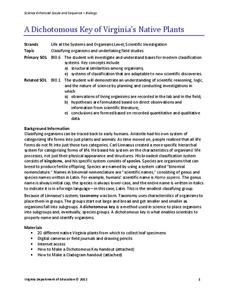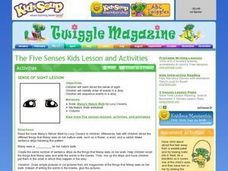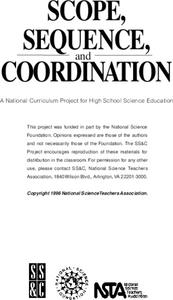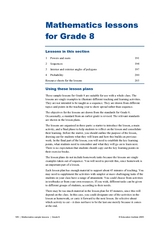Virginia Department of Education
Biotechnological Issues and Bioethics
Culminate a bioethics unit with the implementation of a lesson that incorporates the Socratic method to encourage class feedback and participation. Pupils participate in a discussion on bioethics and morality, complete a...
Polar Trec
Calorimetry Lab
Young people between the ages of 11–13 need on average about 2,000 calories per day. Within the lab, groups learn about calorimetry and respiration. They explore how it pertains to humans and animals living the Arctic where cold...
Virginia Department of Education
A Dichotomous Key of Virginia’s Native Plants
Can your class correctly classify plant species? Individuals explore native plants of the local environment and correctly classify them into their respective categories. They investigate differences in the plants and discuss similarities...
Curated OER
State v. Mary Witch Scripted Mock Trial
Kidnapper or kindly old woman? Kids stage the trial of Mary Witch and must decide if Mary kidnapped Hansel and Gretel or in fact was trying to save them. A script and complete directions are included in the 17-page packet.
Space Science Institute
The "All American" Eclipse Guide
Are you ready for the biggest astronomical event of the year? More importantly ... are you ready to share it with your scholars? Use a presentation filled with facts and diagrams to make sure everyone in class understands the importance...
EngageNY
Grade 9 ELA Module 3, Unit 1, Lesson 5
Ninth graders study the study of animals in an informational text lesson plan that focuses on analyzing text structure. As learners continue reading the first chapter of Temple Grandin's Animals in Translation, they form inquiries and...
EngageNY
Grade 10 ELA Module 2: Unit 1, Lesson 18
Examine how Martin Luther King Jr.'s final paragraphs of "Letter from Birmingham Jail" summarize the ideas throughout the piece. Readers discuss word usage and new vocabulary and complete guided questions to better understand how the...
Lakeshorelearning
Read and Write about It
Reading informational text is a skill that transcends subjects and grade levels. Practice reading about different topics in various formats with a language arts lesson that includes opportunities for writing and research as well.
Curated OER
Sense of Sight Lesson
Students sequence what they saw in the book Maisy's Nature Walk. In this sequencing lesson plan, the teacher reads the book and the children listen and observe. Once the book is read, the students have to sequence what Maisy saw on her...
Curated OER
The Billy Goats Gruff and the Days of the Week
First graders explore the days of the week. In this days of the week lesson, 1st graders listen to the story The Billy Goats Gruff, then act out the events by stepping on "rocks" that name the days of the week. Students must...
Curated OER
The King's Chessboard
Middle schoolers speculate on the better rate of pay: a dollar a day for 10 days, or a penny the first day, two pennies the second, doubling each day for 10 days. Start by listening to the story The King's Chessboard, by David Birch....
Curated OER
Rooster's Night Out
Mitch Weiss and Martha Hamilton's Rooster's Night Out, a retelling of a classic Cuba folktale, launches a cross-curricular study of Cuban cultural traditions. Class members draw the characters from the book, participate in math and...
Curated OER
Journey Through Time
Middle schoolers examine the movement of the Bison over the land bridge. In groups, they use the events to put them into the correct sequence. They apply measurement to chronological time and read more information about the land bridge.
Curated OER
Reproduction, Day 2: Pregnancy
Nearly all young scholars have seen pregnant women and may have questions about human development. Intended for secondary students with mild to moderate mental disabilities, this lesson defines the process of pregnancy in a...
Curated OER
Work and Energy
The first activity may not work for your class if you don't have access to an open area of 30 meters and two cars of different masses, but the remaining activities can be used in any physics course. They all involve the investigation of...
English Enhanced Scope and Sequence
Identifying Synonyms
"Let the hunt begin!" As an introduction to synonyms, second graders generate a list of word pairs that have similar meanings. The words pairs are written on sentence strips, cut apart, shuffled, and distributed to class members who must...
Curated OER
Law of Conservation of Momentum
A suggested sequence of events lays out five hands-on activities and four creative assessments on the conservation of momentum. Using spring scales and mail scales, junior physicists examine Newton's Third Law. After you have taught the...
EngageNY
Grade 5 Math Module 1, Topic A, Lesson 3
The activity introduces exponents as a way to write powers of 10 and to associate those powers with place value. Pupils practice writing powers of 10 with exponents along with multiplying numbers by powers of 10. The resource is the...
Curated OER
The Impact
Learn about the destruction of the rainforest by analyzing statistics. Young learners make an original line graph showing destruction in the rainforest. Additional activities include making a collage, sequencing Dr. Seuss' The...
Curated OER
Powers and Roots
Eighth graders determine the square and cube roots of given numbers in this math lesson. They determine the missing number in a sequence. Additionally, they calculate the interior and exterior polygon angles.
Curated OER
Counting Circles
Here is another learning game that will engage your kindergartners and support them with their counting fluency. Forming a circle where everyone faces inward, choose a counting sequence (counting frontward or backward) with no more than...
Scholastic
Holes Match 'Em Up Challenge
Upper graders read the book Holes as a class or by themselves. In groups, they identify symbols and discuss how they are connected among the many plots in the story. They create a timeline in which they sequence the main...
Curated OER
Using Rhythm to Teach Patterns and Directions
Introduce young learners to line dancing. Here are some simple movement patterns to teach them. First teach, repeat, and repeat again without music. Then when they have a pretty good grasp of the movement patterns, add music and practice...
Perkins School for the Blind
Letter Confusion
Teaching a child with low or no vision how to read is the same as teaching a sighted child how to read — it all starts with letter recognition. This is a simple way to provide your learners with an opportunity to practice reading and...
Other popular searches
- Story Sequencing Activities
- Free Sequencing Activities
- Pizza Sequencing Activities
- Math Sequencing Activities
- Sequencing Activities 3rd
- Sequencing Activities Apples
- Money Sequencing Activities
- English Sequencing Activities
- Recipe Sequencing Activities
- Reading Sequencing Activities























